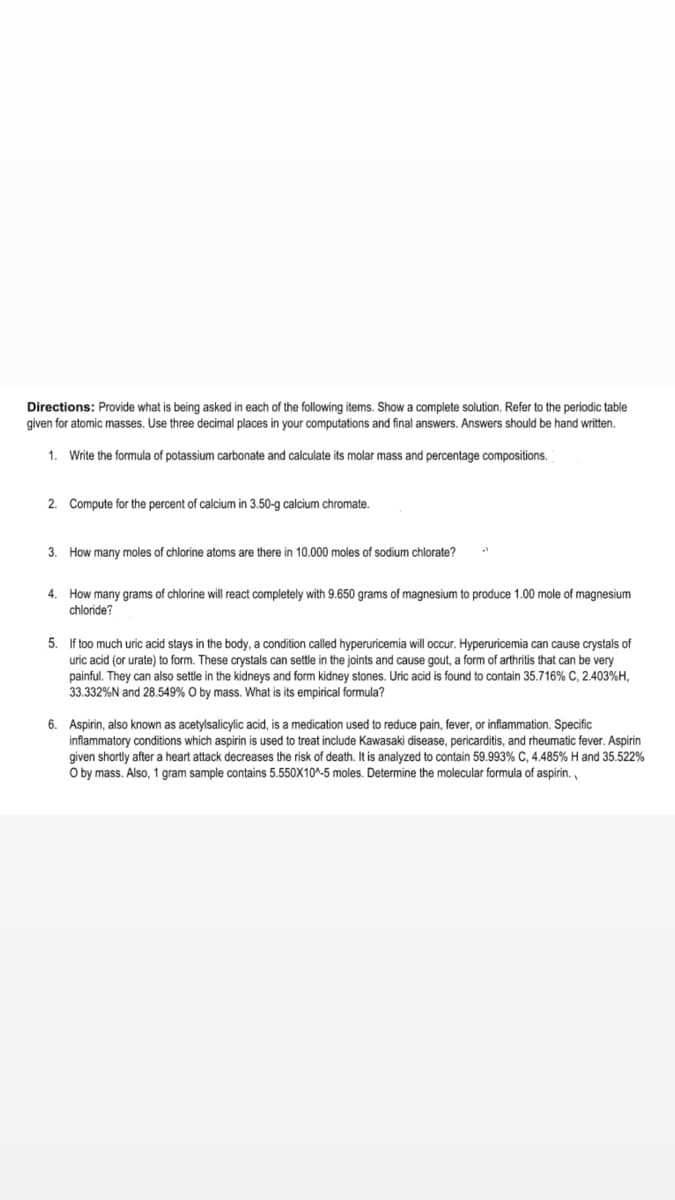Directions: Provide what is being asked in each of the following items. Show a complete solution. Refer to the periodic table given for atomic masses. Use three decimal places in your computations and final answers. Answers should be hand written. 1. Write the formula of potassium carbonate and calculate its molar mass and percentage compositions. 2. Compute for the percent of calcium in 3.50-g calcium chromate. 3. How many moles of chlorine atoms are there in 10.000 moles of sodium chlorate? 4. How many grams of chlorine will react completely with 9.650 grams of magnesium to produce 1.00 mole of magnesium chloride? 5. If too much uric acid stays in the body, a condition called hyperuricemia will occur. Hyperuricemia can cause crystals of uric acid (or urate) to form. These crystals can settle in the joints and cause gout, a form of arthritis that can be very painful. They can also settle in the kidneys and form kidney stones. Uric acid is found to contain 35.716% C, 2.403%H, 33.332%N and 28.549% O by mass. What is its empirical formula? 6. Aspirin, also known as acetylsalicylic acid, is a medication used to reduce pain, fever, or inflammation. Specific inflammatory conditions which aspirin is used to treat include Kawasaki disease, pericarditis, and rheumatic fever. Aspirin given shortly after a heart attack decreases the risk of death. It is analyzed to contain 59.993% C, 4.485% H and 35.522% O by mass. Also, 1 gram sample contains 5.550x10^-5 moles. Determine the molecular formula of aspirin.,
Directions: Provide what is being asked in each of the following items. Show a complete solution. Refer to the periodic table given for atomic masses. Use three decimal places in your computations and final answers. Answers should be hand written. 1. Write the formula of potassium carbonate and calculate its molar mass and percentage compositions. 2. Compute for the percent of calcium in 3.50-g calcium chromate. 3. How many moles of chlorine atoms are there in 10.000 moles of sodium chlorate? 4. How many grams of chlorine will react completely with 9.650 grams of magnesium to produce 1.00 mole of magnesium chloride? 5. If too much uric acid stays in the body, a condition called hyperuricemia will occur. Hyperuricemia can cause crystals of uric acid (or urate) to form. These crystals can settle in the joints and cause gout, a form of arthritis that can be very painful. They can also settle in the kidneys and form kidney stones. Uric acid is found to contain 35.716% C, 2.403%H, 33.332%N and 28.549% O by mass. What is its empirical formula? 6. Aspirin, also known as acetylsalicylic acid, is a medication used to reduce pain, fever, or inflammation. Specific inflammatory conditions which aspirin is used to treat include Kawasaki disease, pericarditis, and rheumatic fever. Aspirin given shortly after a heart attack decreases the risk of death. It is analyzed to contain 59.993% C, 4.485% H and 35.522% O by mass. Also, 1 gram sample contains 5.550x10^-5 moles. Determine the molecular formula of aspirin.,
Introductory Chemistry: A Foundation
9th Edition
ISBN:9781337399425
Author:Steven S. Zumdahl, Donald J. DeCoste
Publisher:Steven S. Zumdahl, Donald J. DeCoste
Chapter15: Solutions
Section: Chapter Questions
Problem 96AP
Related questions
Question
Answer number 1 and 2

Transcribed Image Text:Directions: Provide what is being asked in each of the following items. Show a complete solution. Refer to the periodic table
given for atomic masses. Use three decimal places in your computations and final answers. Answers should be hand written.
1. Write the formula of potassium carbonate and calculate its molar mass and percentage compositions.
2. Compute for the percent of calcium in 3.50-g calcium chromate.
3. How many moles of chlorine atoms are there in 10.000 moles of sodium chlorate?
4. How many grams of chlorine will react completely with 9.650 grams of magnesium to produce 1.00 mole of magnesium
chloride?
5. If too much uric acid stays in the body, a condition called hyperuricemia will occur. Hyperuricemia can cause crystals of
uric acid (or urate) to form. These crystals can settle in the joints and cause gout, a form of arthritis that can be very
painful. They can also settle in the kidneys and form kidney stones. Uric acid is found to contain 35.716% C, 2.403%H,
33.332%N and 28.549% O by mass. What is its empirical formula?
6. Aspirin, also known as acetylsalicylic acid, is a medication used to reduce pain, fever, or inflammation. Specific
inflammatory conditions which aspirin is used to treat include Kawasaki disease, pericarditis, and rheumatic fever. Aspirin
given shortly after a heart attack decreases the risk of death. It is analyzed to contain 59.993% C, 4.485% H and 35.522%
O by mass. Also, 1 gram sample contains 5.550X10^-5 moles. Determine the molecular formula of aspirin.
Expert Solution
This question has been solved!
Explore an expertly crafted, step-by-step solution for a thorough understanding of key concepts.
This is a popular solution!
Trending now
This is a popular solution!
Step by step
Solved in 2 steps with 2 images

Knowledge Booster
Learn more about
Need a deep-dive on the concept behind this application? Look no further. Learn more about this topic, chemistry and related others by exploring similar questions and additional content below.Recommended textbooks for you

Introductory Chemistry: A Foundation
Chemistry
ISBN:
9781337399425
Author:
Steven S. Zumdahl, Donald J. DeCoste
Publisher:
Cengage Learning

Chemistry: An Atoms First Approach
Chemistry
ISBN:
9781305079243
Author:
Steven S. Zumdahl, Susan A. Zumdahl
Publisher:
Cengage Learning


Introductory Chemistry: A Foundation
Chemistry
ISBN:
9781337399425
Author:
Steven S. Zumdahl, Donald J. DeCoste
Publisher:
Cengage Learning

Chemistry: An Atoms First Approach
Chemistry
ISBN:
9781305079243
Author:
Steven S. Zumdahl, Susan A. Zumdahl
Publisher:
Cengage Learning


Chemistry
Chemistry
ISBN:
9781305957404
Author:
Steven S. Zumdahl, Susan A. Zumdahl, Donald J. DeCoste
Publisher:
Cengage Learning

Introductory Chemistry: An Active Learning Approa…
Chemistry
ISBN:
9781305079250
Author:
Mark S. Cracolice, Ed Peters
Publisher:
Cengage Learning

World of Chemistry, 3rd edition
Chemistry
ISBN:
9781133109655
Author:
Steven S. Zumdahl, Susan L. Zumdahl, Donald J. DeCoste
Publisher:
Brooks / Cole / Cengage Learning